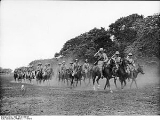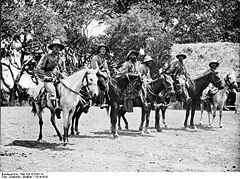
Battle of Kilimanjaro
Encyclopedia
The Battle of Kilimanjaro at Longido took place in German East Africa
in November 1914 and was an early skirmish during the East African Campaign
of the First World War.
. The plan was designed at a Mombasa
staff conference with Major General A. E. Aitken
in overall command. The first and largest prong was to be the capture of Tanga
with the British Indian Expeditionary Force "B" of some 8,000 men in two brigades.
The second prong would be an attack on the German defenses at Longido in the north around Kilimanjaro, then swing south and seize Neu Moshi, the western terminus of the Usambara
or Northern Railroad. "The objective for the capture of Longido was to squeeze the German Schutztruppe
in the upper end of a two-hundred-mile pincer." The region was a major German settlement area with established plantations of sisal, coffee and other cash crops at the northern edge of the Usambara
highlands. Since small German raiding parties had already begun to ambush British detachments and attack the Uganda Railway, the destruction of German forces in the area bordering British East Africa was a key objective of the British plan of operation. “The strategy was faultless on paper.”
By late October 1914 the British Indian Expeditionary Force "C" gathered with 4,000 men near the border of British and German East Africa, commanded by Brigadier General J. M. Stewart. The brigade included colonial volunteers who called themselves East Africa Mounted Rifles. Flawed intelligence reports estimated the German military presence in the region at 200 men; however, there were 600 askari
s in three companies plus the colonial volunteers of 8th Schützenkompagnie [rifle company] of 86 young Germans on horseback.
of the British force came up the slope at night near Longido and, at daylight in the morning fog were caught in the crossfire of a strong German defensive position. The large force of Indian infantry fought well when counterattacked, however, during the day the British attackers made no headway, but suffered substantial casualties.
 By mid-morning, a mounted patrol of the 8th Rifle Company ambushed a British supply column; roughly 100 mules carrying water for the troops were stampeded away by the German horsemen. Some of the carriers in the column panicked and dropped their loads leaving food, ammunition and equipment behind. The British officers with their now widely scattered troops waited until darkness, determined their situation to be untenable, pulled out and down the mountain and marched back to British East Africa having accomplished nothing. This defeat of the invaders by a force less than half their size cooled the enthusiasm for war especially among the British colonial volunteers.
By mid-morning, a mounted patrol of the 8th Rifle Company ambushed a British supply column; roughly 100 mules carrying water for the troops were stampeded away by the German horsemen. Some of the carriers in the column panicked and dropped their loads leaving food, ammunition and equipment behind. The British officers with their now widely scattered troops waited until darkness, determined their situation to be untenable, pulled out and down the mountain and marched back to British East Africa having accomplished nothing. This defeat of the invaders by a force less than half their size cooled the enthusiasm for war especially among the British colonial volunteers.
German East Africa
German East Africa was a German colony in East Africa, which included what are now :Burundi, :Rwanda and Tanganyika . Its area was , nearly three times the size of Germany today....
in November 1914 and was an early skirmish during the East African Campaign
East African Campaign (World War I)
The East African Campaign was a series of battles and guerrilla actions which started in German East Africa and ultimately affected portions of Mozambique, Northern Rhodesia, British East Africa, Uganda, and the Belgian Congo. The campaign was effectively ended in November 1917...
of the First World War.
Background
The British conquest of German East Africa was planned as a two-pronged invasion of the German colony, at (1) the port town of Tanga and (2) the settlement Longido on the slopes of Mount KilimanjaroMount Kilimanjaro
Kilimanjaro, with its three volcanic cones, Kibo, Mawenzi, and Shira, is a dormant volcano in Kilimanjaro National Park, Tanzania and the highest mountain in Africa at above sea level .-Geology:...
. The plan was designed at a Mombasa
Mombasa
Mombasa is the second-largest city in Kenya. Lying next to the Indian Ocean, it has a major port and an international airport. The city also serves as the centre of the coastal tourism industry....
staff conference with Major General A. E. Aitken
Arthur Aitken
Major General Arthur Edward Aitken was a British military commander.Born in Rochford in Essex, by the time of the 1871 Census he was a 9-year old pupil at a school in Brighton, Sussex.He began his military career in 1882 as a cavalryman...
in overall command. The first and largest prong was to be the capture of Tanga
Battle of Tanga
The Battle of Tanga, sometimes also known as the Battle of the Bees, was the unsuccessful attack by the British Indian Expeditionary Force “B” under Major General A.E. Aitken to capture German East Africa during World War I in concert with the invasion Force “C” near Longido on the slopes of...
with the British Indian Expeditionary Force "B" of some 8,000 men in two brigades.
The second prong would be an attack on the German defenses at Longido in the north around Kilimanjaro, then swing south and seize Neu Moshi, the western terminus of the Usambara
Usambara Railway
The Usambara-Railway was the first railway to be built in German East Africa and what is today Tanzania.- German East-Africa :A railway company was created in 1891 with the aim, to connect the port of Tanga at the Indian Ocean with the Lake Victoria by passing south of the Usambara Mountains. ...
or Northern Railroad. "The objective for the capture of Longido was to squeeze the German Schutztruppe
Schutztruppe
Schutztruppe was the African colonial armed force of Imperial Germany from the late 19th century to 1918, when Germany lost its colonies. Similar to other colonial forces, the Schutztruppe consisted of volunteer European commissioned and non-commissioned officers, medical and veterinary officers. ...
in the upper end of a two-hundred-mile pincer." The region was a major German settlement area with established plantations of sisal, coffee and other cash crops at the northern edge of the Usambara
Usambara Mountains
The Usambara Mountains are a mountain range in North-East Tanzania, approximately long and ranging from 20 to in width. Mountains in the range rise as high as 8,000 ft ....
highlands. Since small German raiding parties had already begun to ambush British detachments and attack the Uganda Railway, the destruction of German forces in the area bordering British East Africa was a key objective of the British plan of operation. “The strategy was faultless on paper.”
By late October 1914 the British Indian Expeditionary Force "C" gathered with 4,000 men near the border of British and German East Africa, commanded by Brigadier General J. M. Stewart. The brigade included colonial volunteers who called themselves East Africa Mounted Rifles. Flawed intelligence reports estimated the German military presence in the region at 200 men; however, there were 600 askari
Askari
Askari is an Arabic, Bosnian, Urdu, Turkish, Somali, Persian, Amharic and Swahili word meaning "soldier" . It was normally used to describe local troops in East Africa, Northeast Africa, and Central Africa serving in the armies of European colonial powers...
s in three companies plus the colonial volunteers of 8th Schützenkompagnie [rifle company] of 86 young Germans on horseback.
Battle
On 3 November 1914 some 1,500 PunjabisPunjab (British India)
Punjab was a province of British India, it was one of the last areas of the Indian subcontinent to fall under British rule. With the end of British rule in 1947 the province was split between West Punjab, which went to Pakistan, and East Punjab, which went to India...
of the British force came up the slope at night near Longido and, at daylight in the morning fog were caught in the crossfire of a strong German defensive position. The large force of Indian infantry fought well when counterattacked, however, during the day the British attackers made no headway, but suffered substantial casualties.

Aftermath
The northern prong attack at Longido had been intended as little more than a diversion. "The main effort was [the] ambitious amphibian assault on the port of Tanga" that commenced on 2 November 1914. With the northern prong accounted for, the askari companies were shuttled by rail to Tanga to assist in opposing the southern prong.See also
- Battle of TangaBattle of TangaThe Battle of Tanga, sometimes also known as the Battle of the Bees, was the unsuccessful attack by the British Indian Expeditionary Force “B” under Major General A.E. Aitken to capture German East Africa during World War I in concert with the invasion Force “C” near Longido on the slopes of...
- Paul Emil von Lettow-VorbeckPaul Emil von Lettow-VorbeckPaul Emil von Lettow-Vorbeck was a general in the Imperial German Army and the commander of the German East Africa campaign. For four years, with a force that never exceeded about 14,000 , he held in check a much larger force of 300,000 British, Belgian, and Portuguese troops...

